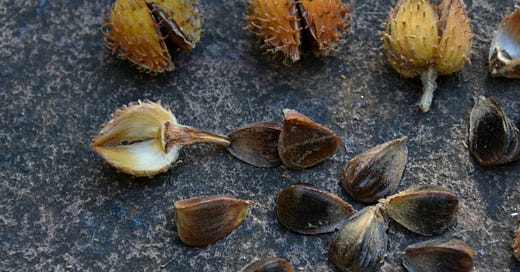ISSUE 94, EATING TREES, Part 1: American Beech
American Beech (Fagus grandifolia)
A mature American beech tree can be an impressive thing. Titanic in height and girth with a crown spanning over 70 feet in width, they impress especially in winter when in a stand of hardwoods the beeches will be the only trees retaining their leaves. Aged to a parchment brown, the aromatic clusters of toothed oval leaves will remain until new growth pushes them off at the outset of Spring. In autumn those leaves shine golden yellow in great profusion, slowing transmuting to crisp old paper in December.
I did not know that the leaves were edible until a forester in east Tennessee informed me. I did know that their springiness and aroma caused country folk to stuff pillowcases full of them. These were used particularly by people prone to insomnia. But the new-fledged leaves are picked and savored as a salad green, with their tenderness and citric kick. Those who each beech leaves do so when they have just unfurled and not fully taken on the shape of a mature leaf. They are not cooked, but consumed raw with an acid and oil dressing. Deer feast on the leaves, when they are in reach, and so do a multitude of insects, which results in mature beech stands being mobbed by birds. They don’t eat the leaves, just the insects on the leaves.
Those insects have some major negative consequences. The spikey hulls of beechnuts often prove inadequate to protect the forming mast inside. Most beechnuts you open are infested with wormy insect larva. It is a reason why beechnuts, which constituted an important human and animal food source for centuries—a mainstay of Native American diets—never became a commodity nut. The Chippewa avoided the disappointment of opening ruined nuts by seeking out chipmunk hoards rather than collecting directly from the trees. The Chipmunks never stored an infested nut.
The flavor of beechnut is inflected by the soil on which it grows. Clay soils tend to produce more tannic mast. Fagin and tannin concentrate in the sheath covering the kernel and insulating it from the burr. The Cherokees used these rather acrid nuts with sheaths intact as a vermifuge, and reports suggest that they effectively eliminated worms in one’s gut. These nuts were mildly toxic. Removal of the sheath eliminates most of the toxicity. Many t Trees grown on more sandy soils, lacked the tannin and toxicity. And if you stripped the sheath off the nuts were harmless and could be and were eaten raw by Natives and country folk. If one found a stand of mild flavored nuts, you had an excellent source of food. The burrs when mature split and enabled the triangular nuts to spill out when the burrs fall. Trees must be well over 30 years old (in some cases 40) before they begin producing nuts. Nutting occurs on a two or three year cycle, not annually.
The oil pressed from beechnut is used in European cookery; not so much in the United States. Up to 20% of the nut is edible lipid, and about that much protein as well. Most suppliers of beechnut oil are European and do not use American Beech as their source.Am




